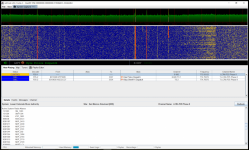You are using an out of date browser. It may not display this or other websites correctly.
You should upgrade or use an alternative browser.
You should upgrade or use an alternative browser.
LCRA P25 Now Has OTAA
- Thread starter Boingel331
- Start date
Could you explain what this is please?? I am not in the radio business, professional or ham, just a scanner listener. Thx!!
Project25_MASTR
Millennial Graying OBT Guy
Over the Air Aliasing
TLR2019
Random Member
#explain it like I am 5
The system admins for LCRA have enabled the control channel data stream to display not only the Unit ID number of the radio, but its “alias” which helps to identify the department. SDR monitoring software are able to display that data for us hobbyists. Not sure if commercial scanners display it like Unidens do for NXDN UIDs or not but I’d bet they do.#explain it like I am 5
Ok, so those of us who use Unitrunker, is there a setting to make that appear or would it show up in the file that is created?The system admins for LCRA have enabled the control channel data stream to display not only the Unit ID number of the radio, but its “alias” which helps to identify the department. SDR monitoring software are able to display that data for us hobbyists. Not sure if commercial scanners display it like Unidens do for NXDN UIDs or not but I’d bet they do.
TLR2019
Random Member
When I was scanning Kerr County. On gattrs. It automatically put in the alias for me. So If you are using SDR, I do not believe any setting change is necessary
The alias is sent as part of the voice transmission - since Unitrunker doesn't support Phase 2 voice you won't be able to receive it unless there are talkgroups that are running Phase 1 voice that have it enabled (aliasing is enabled on a per-talkgroup basis). SDRTrunk and DSDPlus (Fastlane Edition) both can decode Phase 2 voice and now support decoding the over-the-air ailiases.Ok, so those of us who use Unitrunker, is there a setting to make that appear or would it show up in the file that is created?
So will this allow the identification of TG's easier?? For example, on the Boerne LCRA site, during yesterday's flooding, a patch was created between Kerrville FD and LCRAP25 1001, which also had a designator of "Radio Testing". Is this a "testing" tg still or is it a tg for a system patch? Hope my question makes sense.
BM82557
Member
Checked my Dsdplus Fastlane alias stats text file, as of the time of this posting 1562 radio aliases have been identified on 92571.200 LCRA
Harris Systems like LCRA do patches by creating a "virtual" talkgroup, and most scanners and decoding software will see that virtual talkgroup (although the patched channels are reported OTA). So depending on what the system administrator defined as their patch range, the patched talkgroup ID's could change with each use, making labeling the patches with anything other than a generic "patch" label a futile effort.So will this allow the identification of TG's easier?? For example, on the Boerne LCRA site, during yesterday's flooding, a patch was created between Kerrville FD and LCRAP25 1001, which also had a designator of "Radio Testing". Is this a "testing" tg still or is it a tg for a system patch? Hope my question makes sense.
Someone with one of the Software based solutions (DSDPlus Fastlane, SDRTrunk or Unitrunker) should be able to see the patches and identify the "virtual" talkgroup. With enough monitoring of patches they could determine what range the patches use.
Motorola systems on the other hand (GATRRS), don't use virtual talkgroup numbers, and just channel grant all the patched talkgroups, so you will see one of the patched talkgroups display on your scanner.
Could you explain what this is please?? I am not in the radio business, professional or ham, just a scanner listener. Thx!!
When I was scanning Kerr County. On gattrs. It automatically put in the alias for me. So If you are using SDR, I do not believe any setting change is necessary
If you are not using an SDR and software that supports OTA decoding of the radio alias this won't help you. OTA radio aliases are the user/unit named assigned to the radio for identification by dispatchers and other units, it appears when they key up. It is not available in scanners yet, just using an SDR and software that supports it.
So will this allow the identification of TG's easier??
This feature is for radio aliases, not TG aliases
Project25_MASTR
Millennial Graying OBT Guy
The correct term is supergrouping, and GATRRS does supergroup as well. The catch is super grouping on a Motorola system can only be done from a Motorola console with a network connection to the system. Harris systems will supergroup with any CSSI connected console.Harris Systems like LCRA do patches by creating a "virtual" talkgroup, and most scanners and decoding software will see that virtual talkgroup (although the patched channels are reported OTA). So depending on what the system administrator defined as their patch range, the patched talkgroup ID's could change with each use, making labeling the patches with anything other than a generic "patch" label a futile effort.
Someone with one of the Software based solutions (DSDPlus Fastlane, SDRTrunk or Unitrunker) should be able to see the patches and identify the "virtual" talkgroup. With enough monitoring of patches they could determine what range the patches use.
Motorola systems on the other hand (GATRRS), don't use virtual talkgroup numbers, and just channel grant all the patched talkgroups, so you will see one of the patched talkgroups display on your scanner.
Similar threads
- Replies
- 14
- Views
- 737
- Replies
- 1
- Views
- 200
- Replies
- 5
- Views
- 305


